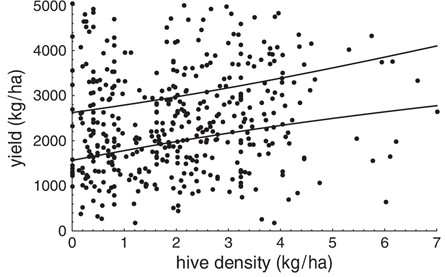Successful pollination is just one of the many factors which contribute to the total yield of a wild blueberry field. Some aspects of pollination are out of our control, such as weather conditions during bloom, but others can be managed to increase pollination success. In this week’s blog, we will pick up where we left off in our discussion of honey bee hive stocking rates on wild blueberry fields.
Honey Bee Stocking Density on Wild Blueberries: Part 2
We ended the blog last week with a table of various suggestions for hive stocking rates on wild blueberry fields, seen below.
|
Stocking Density (hives/hectare) |
||
|
Hive number |
Location |
Reference |
|
10 (range 4.5–12.5) |
Maine |
Asare et al. 2017 |
|
10 |
NS & NB |
McCallum 2020 |
|
5 – 7.5 |
NB |
NB DAAF (ND) |
|
5 – 12 |
NS |
Eaton et al. 2004 |
Most of these recommendations suggest a range of hive
numbers. This range reflects the reality that each field is unique. One field might
benefit most from having 6 hives/ha while another requires 10 hives/ha to
achieve maximum pollination success. Other factors which contribute to the
impact of hive density are field coverage, wild pollinator populations,
microclimate, and other applications or treatments.
Research has shown pollination success and blueberry yields to increase with greater stocking rates of hives (Bushman and Drummond 2020, McCallum et al. 2020). However, adding more hives to a field will not increase yields indefinitely. Eaton and Nams (2012) demonstrated that there is a limit to this linear relationship between stocking density and berry yield (see figure below).
This research suggests that after approximately 4 hives/ha, the positive linear relationship between stocking density and berry yield becomes less defined. After this point, it is the characteristics of the individual field which dictate the necessity for more hives. For example, field coverage, wild pollinator populations, microclimate. Each field must be considered individually to achieve maximum pollination potential. Researchers have also considered the value of each hive, individually, to a field. Studies have conservatively estimated that each individual honey bee colony placed on a wild blueberry field during pollination will increase yields between 192-400 kg/ha (Eaton and Nams 2012; Yarborough 2004). Other work has set the per hive increase in yield as high as 1971 kg / ha (Bushman & Drummond, 2020). After a stocking rate of perhaps around 7 – 8 hives per hectare, yields will more significantly be influenced by individual fields characteristics and the investment may begin to outweigh the cost. Higher stocking rates need to be carefully considered against individual field potential!
Overall, a review of the relevant research demonstrates a
significant value in adding honey bee colonies to wild blueberry fields.
Optimal stocking rates will vary based on the individual season and field but,
generally, minimal stocking has revealed a strong, positive relationship with
increasing pollination success and subsequent berry yield. This means that on
the average wild blueberry field, pollination success of blooms will increase
steadily with stocking rates up to a point and after this, the individual
characteristics of the field will dictate how much each additional hive will improve
pollination. As the potential yields of fields increases due to better farming
practices, this minimum stocking rate needs to be reviewed. Successful
pollination is critical to the development of ripe, harvestable berries. In the
upcoming blogs, we will continue with the topic of achieving optimal
pollination services through discussion of hive placement in the fields and the
strength of the colonies within.
New Brunswick Honey Bee Expansion Program!
Applications are open for the NB Honey Bee Expansion
Program! Click
here for a program overview where you can find the application
form and program
guidelines listed in the sidebar on the right.
Connecting with ATTTA Specialists

